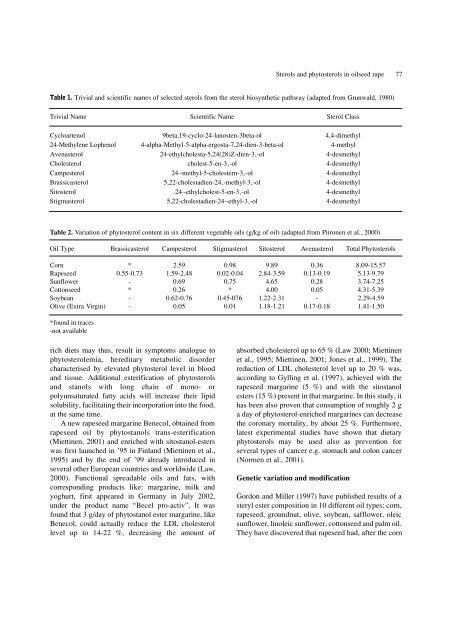Sterols and the phytosterol content in oilseed rape - Journal of Cell ...
Sterols and the phytosterol content in oilseed rape - Journal of Cell ...
Sterols and the phytosterol content in oilseed rape - Journal of Cell ...
You also want an ePaper? Increase the reach of your titles
YUMPU automatically turns print PDFs into web optimized ePapers that Google loves.
ich diets may thus, result <strong>in</strong> symptoms analogue to<br />
<strong>phytosterol</strong>emia, hereditary metabolic disorder<br />
characterised by elevated <strong>phytosterol</strong> level <strong>in</strong> blood<br />
<strong>and</strong> tissue. Additional esterification <strong>of</strong> <strong>phytosterol</strong>s<br />
<strong>and</strong> stanols with long cha<strong>in</strong> <strong>of</strong> mono- or<br />
polyunsaturated fatty acids will <strong>in</strong>crease <strong>the</strong>ir lipid<br />
solubility, facilitat<strong>in</strong>g <strong>the</strong>ir <strong>in</strong>corporation <strong>in</strong>to <strong>the</strong> food,<br />
at <strong>the</strong> same time.<br />
A new <strong>rape</strong>seed margar<strong>in</strong>e Benecol, obta<strong>in</strong>ed from<br />
<strong>rape</strong>seed oil by phytostanols trans-esterification<br />
(Miett<strong>in</strong>en, 2001) <strong>and</strong> enriched with sitostanol-esters<br />
was first launched <strong>in</strong> ’95 <strong>in</strong> F<strong>in</strong>l<strong>and</strong> (Miett<strong>in</strong>en et al.,<br />
1995) <strong>and</strong> by <strong>the</strong> end <strong>of</strong> ’99 already <strong>in</strong>troduced <strong>in</strong><br />
several o<strong>the</strong>r European countries <strong>and</strong> worldwide (Law,<br />
2000). Functional spreadable oils <strong>and</strong> fats, with<br />
correspond<strong>in</strong>g products like: margar<strong>in</strong>e, milk <strong>and</strong><br />
yoghurt, first appeared <strong>in</strong> Germany <strong>in</strong> July 2002,<br />
under <strong>the</strong> product name “Becel pro-activ”. It was<br />
found that 3 g/day <strong>of</strong> phytostanol ester margar<strong>in</strong>e, like<br />
Benecol, could actually reduce <strong>the</strong> LDL cholesterol<br />
level up to 14-22 %, decreas<strong>in</strong>g <strong>the</strong> amount <strong>of</strong><br />
<strong>Sterols</strong> <strong>and</strong> <strong>phytosterol</strong>s <strong>in</strong> <strong>oilseed</strong> <strong>rape</strong> 77<br />
Table 1. Trivial <strong>and</strong> scientific names <strong>of</strong> selected sterols from <strong>the</strong> sterol biosyn<strong>the</strong>tic pathway (adapted from Grunwald, 1980)<br />
Trivial Name Scientific Name Sterol Class<br />
Cycloartenol 9beta,19-cyclo-24-lanosten-3beta-ol 4,4-dimethyl<br />
24-Methylene Lophenol 4-alpha-Methyl-5-alpha-ergosta-7,24-dien-3-beta-ol 4-methyl<br />
Avenasterol 24-ethylcholesta-5,24(28)Z-dien-3‚-ol 4-desmethyl<br />
Cholesterol cholest-5-en-3‚-ol 4-desmethyl<br />
Campesterol 24·-methyl-5-cholestern-3‚-ol 4-desmethyl<br />
Brassicasterol 5,22-cholestadien-24‚-methyl-3‚-ol 4-desmethyl<br />
Sitosterol 24·-ethylcholest-5-en-3‚-ol 4-desmethyl<br />
Stigmasterol 5,22-cholestadien-24·-ethyl-3‚-ol 4-desmethyl<br />
Table 2. Variation <strong>of</strong> <strong>phytosterol</strong> <strong>content</strong> <strong>in</strong> six different vegetable oils (g/kg <strong>of</strong> oil) (adapted from Piironen et al., 2000)<br />
Oil Type Brassicasterol Campesterol Stigmasterol Sitosterol Avenasterol Total Phytosterols<br />
Corn * 2.59 0.98 9.89 0.36 8.09-15.57<br />
Rapeseed 0.55-0.73 1.59-2.48 0.02-0.04 2.84-3.59 0.13-0.19 5.13-9.79<br />
Sunflower - 0.69 0.75 4.65 0.28 3.74-7.25<br />
Cottonseed * 0.26 * 4.00 0.05 4.31-5.39<br />
Soybean - 0.62-0.76 0.45-076 1.22-2.31 - 2.29-4.59<br />
Olive (Extra Virg<strong>in</strong>) - 0.05 0.01 1.18-1.21 0.17-0.18 1.41-1.50<br />
*found <strong>in</strong> traces<br />
-not available<br />
absorbed cholesterol up to 65 % (Law 2000; Miett<strong>in</strong>en<br />
et al., 1995; Miett<strong>in</strong>en, 2001; Jones et al., 1999). The<br />
reduction <strong>of</strong> LDL cholesterol level up to 20 % was,<br />
accord<strong>in</strong>g to Gyll<strong>in</strong>g et al. (1997), achieved with <strong>the</strong><br />
<strong>rape</strong>seed margar<strong>in</strong>e (5 %) <strong>and</strong> with <strong>the</strong> sitostanol<br />
esters (15 %) present <strong>in</strong> that margar<strong>in</strong>e. In this study, it<br />
has been also proven that consumption <strong>of</strong> roughly 2 g<br />
a day <strong>of</strong> <strong>phytosterol</strong>-enriched margar<strong>in</strong>es can decrease<br />
<strong>the</strong> coronary mortality, by about 25 %. Fur<strong>the</strong>rmore,<br />
latest experimental studies have shown that dietary<br />
<strong>phytosterol</strong>s may be used also as prevention for<br />
several types <strong>of</strong> cancer e.g. stomach <strong>and</strong> colon cancer<br />
(Normen et al., 2001).<br />
Genetic variation <strong>and</strong> modification<br />
Gordon <strong>and</strong> Miller (1997) have published results <strong>of</strong> a<br />
steryl ester composition <strong>in</strong> 10 different oil types: corn,<br />
<strong>rape</strong>seed, groundnut, olive, soybean, safflower, oleic<br />
sunflower, l<strong>in</strong>oleic sunflower, cottonseed <strong>and</strong> palm oil.<br />
They have discovered that <strong>rape</strong>seed had, after <strong>the</strong> corn
















